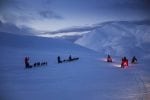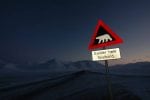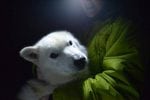Experiencing the Northern Lights or Aurora Borealis, as it is called in Latin, should be on every traveler’s “bucket list”, as this is one of nature’s most spectacular phenomena. Between November and January, there are ideal views on Svalbard with clear and cloudless days / nights and no light pollution. You will never forget the first time you experience the Northern Lights. The light dances across the sky, changes color and shape, grows and pulsates. Svalbard is one of the few places on the globe where you can experience the northern lights in this way – even during the day.
Contact form

Ecorating: 2.5
This product meets our requirements for Ecorating, a product that is good for humans and the environment.
Does my trip make a difference?
Read more
This product meets our requirements for Ecorating, a product that is good for humans and the environment.
Sample Itinerary

After arriving at Longyearbyen Airport, take the shuttle bus to Basecamp Hotel. Before your first night at Trappers Hut, we recommend a city tour. Your guide will meet you at 19:00. We drive to Trappers Hut, which is located approx. 10 km outside Longyearbyen. Enjoy a good dinner followed by overnight stay. Your guide will be near you all night as for safety reasons – this is the polar bear’s natural habitat and hunting ground. But you are not alone: 90 Alaskan Huskies also sleep with you.

We start the day with breakfast in the cottage. If the snow conditions are good, we take the dogs for a walk in the Bolter Valley. Your guide will give you instructions. If there is not so much snow, we take a hike instead. Here in the area outside Longyearbyen we have less light pollution and better conditions to be able to see the northern lights. Svalbard is one of the few places where you can experience the northern lights even during the day. After the trip we return to Longyearbyen and check in at the Trappers Hotel for the next few nights. We recommend dinner at Kroa Restaurant – right next to the hotel.

Today we visit one of the glaciers close to Longyearbyen. Before we start, you will be equipped with a powerful flashlight and snowshoes. The guide shows you how but best to move with snowshoes on. The route depends on the weather and local conditions. Along the way, we enjoy a hot drink and a breathtaking, dark silence. We have great views of the Advent Valley. Your guide tells you about the time when mining was the city’s most important business. Dinner on your own – maybe at the hotel?

Breakfast at the hotel. Maybe visit the city’s museum before the trip goes to the airport. The airport bus runs directly from the hotel.
Trip details
Ecorating: 2.5
When can you travel?October – February
Travel duration: 5 nights
Minimum age: 18 years
Airport: Longyearbyen, Svalbard, Norway
Price includes:
Price does not include: Drinks for meals, activities outside the program, transfer from airport by airport bus, climate compensation 250 NOK
Good to know about Svalbard
Despite Svalbard’s northern location, the archipelago has a relatively mild climate compared to other areas at the same latitude. In summer the temperature is around 5 ° C and usually very little rain, but it is quite common with fog and low clouds. Although it rarely rains, the ground is often wet due to the melting snow. Cold winds are common, even in summer. It must be remembered that the weather on Svalbard can change quickly and local temperatures can vary greatly.
In winter, the average temperature is -14 ° C. Temperatures between -20 and -30 degrees are not uncommon. In combination with wind, temperatures can be extremely low.
Longyearbyen has midnight sun from 19 April to 23 August. During this bright period, the sun never goes below the horizon. In contrast, from late October to mid-February, the sun never appears above the horizon. The dark polar nights last from mid-November to the end of January, and during this period you can not distinguish day from night.
Visa: Danish citizens do not need a visa to Norway.
Time Zone: GMT +1
Vaccination: No vaccinations required.
Packing: With the right packing, plenty of food and good daily routines, you can stay warm, even on cold days. This is of course important so that you can enjoy your Arctic adventure. We recommend everyone to wear wool and stock in stock, wool socks in both summer and winter season. The wind on Svalbard can be strong, and if it blows over the glacier it can feel very cold.
Packing list: We recommend that you bring the following equipment: A solid backpack, bag for personal belongings, warm windproof jacket and trousers, warm down jacket / parka, warm windproof hat, 2 pairs of wool gloves, 1 pair of windproof gloves, 1 pair of work gloves (when handling dogs, etc.), 2 sets of wool underwear and sweater, warm wool or fleece jacket, wool or fleece trousers, 2-3 pairs of wool socks, toiletries, sunglasses, binoculars and camera. Due to limited space in the sleds, we recommend that you bring a minimum of luggage (the remaining luggage can be stored at the Basecamp Trappers Hotel).
Included: All guests receive a warm overall, snow boots, windproof gloves, face mask, goggles and a warm hat. In addition, warm sleeping bags, sleeping pads, tents and necessary camping equipment will be included. Our experienced guide takes care of the guests’ safety and brings all the necessary safety equipment.
Local currency: Norwegian kroner
Weather: Weather Svalbard ondmi.dk
Mobile coverage and internet: The mobile network works well in Norway. Basecamp management recommends that you use your phone discreetly or turn it off.
Safety: Safety instructions are provided on site when you arrive and it is VERY important to follow them. Meeting a polar bear is a great experience, but can also be extremely dangerous situation. All guides are armed around the clock for your safety.

Ecorating: 2.5
This product meets our requirements for Ecorating, a product that is good for humans and the environment.
Does my trip make a difference?
Read more
This product meets our requirements for Ecorating, a product that is good for humans and the environment.
At Basecamp Spitsbergen, people are particularly concerned about the global warming of the planet, as it is most visible in our polar regions. The biggest project we can contribute to address this is by planting trees in Kenya. All guests are encouraged to participate in the project. By planting trees, we can reduce CO2 emissions globally. Your contribution is 250 NOK, which is equivalent to being able to plant 8 trees in Kenya.
In Svalbard, you use as few resources as possible, and use organic products to keep your environmental footprint as small as possible.
At Isfjord Radio an indoor herbal garden has been initiated that supplies the chef with fresh herbs and supplements for the guests’ meals, saving CO2 emissions.
Basecamp Explorer Spitsbergen has also supported the Kapp Linne information project on how to raise awareness on the valued bird sanctuary and its birdlife, managing visitors when experiencing the reserve.
Basecamp Explorer Spitsbergen regularly takes part in clean up activities around the islands.





